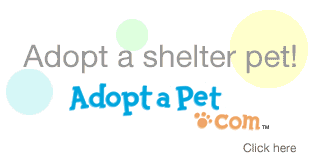Here's a great article that I thought I would pass on...hope you find it interesting! –Kim
Flooding
By: Victoria Stilwell
 Cooper was a 2-year-old male Boxer that responded aggressively towards other dogs. His owners had tried many different methods in an attempt to modify Cooper's behavior, but his reactions towards other dogs just got worse. He displayed threatening behavior when he was being walked on and off the lead except at doggy day care where he seemed to be relaxed and happy with the dogs around him.
Cooper was a 2-year-old male Boxer that responded aggressively towards other dogs. His owners had tried many different methods in an attempt to modify Cooper's behavior, but his reactions towards other dogs just got worse. He displayed threatening behavior when he was being walked on and off the lead except at doggy day care where he seemed to be relaxed and happy with the dogs around him.
This was a fascinating case for me because it posed so many challenges. During my first visit I observed how uncomfortable Cooper was around other dogs, but his owners assured me that he had never displayed this intense reaction until a few months after they had adopted him. At first Cooper had appeared fine with dogs on and away from his territory and of course at day care. But then his behavior began to change and he started to aggress towards dogs on and off the lead. His owners were at a loss as to what to do.
They had tried some harsher methods of discipline including a shock collar to suppress his negative response, but of course this made his reaction worse. Resorting to this and other punitive methods only made Cooper feel more insecure, because the sight of other dogs coming towards him and his subsequent reaction now produced a painful sensation that only served to deepen his discomfort. As far as Cooper was concerned he had found the perfect way to deal with this discomfort – aggress and the other dog would go away. This response became his way of coping whenever another dog was near him, even if it meant that he was severely punished for his reaction.
Why had Cooper's behavior changed so suddenly and so severely? A thorough medical investigation revealed that the pain from an earlier leg injury could have been the cause, but it was also possible that a history of abandonment, his age and possible incidences with other dogs at day care had all contributed towards his insecurity. Even though the staff at day care had told his owners that Cooper was never a problem, I heard a different story. Cooper regularly ended up in time-outs for 'being a bully,' but even taking this into account Cooper was still better behaved at day care than he was out in the big bad world – that had to count for something. His owners were convinced that he enjoyed his days playing at day care and in order to verify this took me to the facility so that I could watch how he interacted with the other dogs.
To the untrained eye, Cooper looked like he was having a good time, but my suspicions were confirmed within the first ten seconds of viewing him in the dog room. This wasn't a dog that was enjoying himself – this was a dog that was experiencing intense stress. Cooper was practicing avoidance, panting and drooling while he constantly paced up and down the room staying close to known exits in an effort to get out. It appeared that he was so overwhelmed with fear from being around other dogs that this prevented him from acting naturally. His survival instinct kicked in and, unable to display his true emotion, Cooper quite literally shut down. This behavioral process is known as 'flooding.'
 Flooding is sometimes used as a therapy to try to 'cure' people or animals of their fears and phobias. The flooding technique goes like this: take a dog-aggressive dog and expose it to as many other dogs as possible in an enclosed environment. In time, the dog's anxiety around other dogs will decrease because the body cannot keep up a stressed out state of alarm for ever. The desired result is that the dog finally relaxes in the presence of the fear as he realizes that other dogs won't hurt him.
Flooding is sometimes used as a therapy to try to 'cure' people or animals of their fears and phobias. The flooding technique goes like this: take a dog-aggressive dog and expose it to as many other dogs as possible in an enclosed environment. In time, the dog's anxiety around other dogs will decrease because the body cannot keep up a stressed out state of alarm for ever. The desired result is that the dog finally relaxes in the presence of the fear as he realizes that other dogs won't hurt him.
In some cases flooding works, but this therapy is controversial because the likelihood of failure is so high. In the majority of cases, flooding only makes a dog more anxious and forces the dog to adopt different coping mechanisms such as fighting, irrespective of how many dogs there are, or shutting down – where the dog becomes almost numb to the environment and behaves in a way that is truly out of character – an instinct that keeps him safe and ensures survival. This shutdown lasts as long as the dog is in the flooding environment, and once back in his comfort zone, the dog is free to be able to show his true feelings again. Cooper looked like he was perfectly fine around the dogs at day care, but the reality was very different.
I advised that Cooper not go to day care again until his rehabilitation was complete. There was a chance that he might never be comfortable enough to cope with what was a pretty stressful environment and this made it even more important that Cooper be trained to cope on a walk with other dogs around him. Cooper's rehabilitation centered on a complete desensitization and counter-conditioning program as well as methods designed to pull his focus away from other dogs onto his owners so he could take cues and direction from them and gain confidence.
As he was a highly food motivated dog, Cooper was given food in the presence of other dogs as part of the desensitization process, to show him that good things happened when other dogs were around him. Slowly, his reactions became less intense as he was able to relax in the presence of his fear. Cooper's owners realized that by using harsh punitive methods to try and stop his response they had only been suppressing the reaction to his emotion and were not addressing why it was happening and what Cooper needed to change the way he felt. It was one thing to suppress his behavior but quite another for him to feel more positively about a fear source – a much better state of being.
Whether flooding is used as a therapy or a dog is unintentionally exposed to an environment that floods the senses, it is important to understand the dynamics of this process and the potential positive or negative effects on the dog. A dog that attacks dogs on and/or off the leash in public is very unlikely to be comfortable around other dogs in a day care environment, even if it looks like it is behaving normally.
Cooper continues to do well and is able to relax in the presence of other dogs on the leash. His environment is continually managed so that he does not have the chance to become overwhelmed and his owners are working with him consistently to ensure that his emotional state continues to change.
http://positively.com/positive-reinforcement/victoria-stilwell-articles/flooding/
© Copyright 2010 Victoria Stilwell Enterprises LLC
 Victoria Stilwell is the host of Animal Planet's "It's Me or the Dog." Her no nonsense, common sense approach to dog training is both practical and effective. It's about educating owners on how to see things from a dog's perspective and use positive reinforcement to encourage good behavior. With a little patience and effort, anyone can live happily with their canine companions. Visit Victoria Stilwell on the Web, get her training tips and watch full episodes of "It's Me or the Dog" by clicking http://animal.discovery.com/tv/its-me-or-dog/index.html or http://www.victoriastilwell.com
Victoria Stilwell is the host of Animal Planet's "It's Me or the Dog." Her no nonsense, common sense approach to dog training is both practical and effective. It's about educating owners on how to see things from a dog's perspective and use positive reinforcement to encourage good behavior. With a little patience and effort, anyone can live happily with their canine companions. Visit Victoria Stilwell on the Web, get her training tips and watch full episodes of "It's Me or the Dog" by clicking http://animal.discovery.com/tv/its-me-or-dog/index.html or http://www.victoriastilwell.com




































